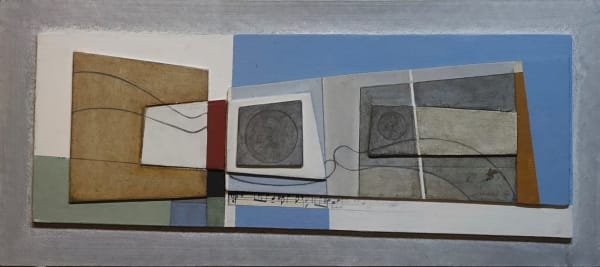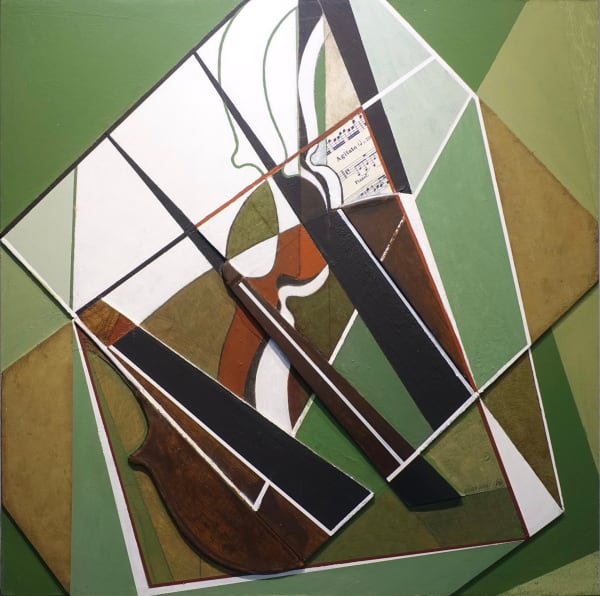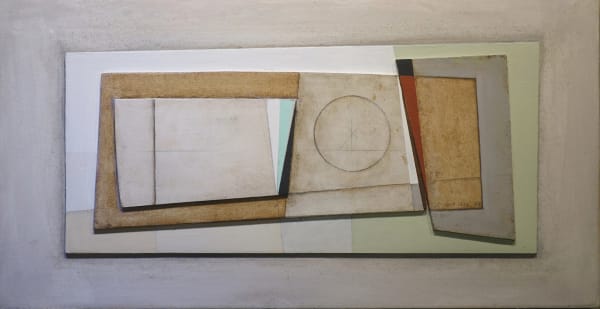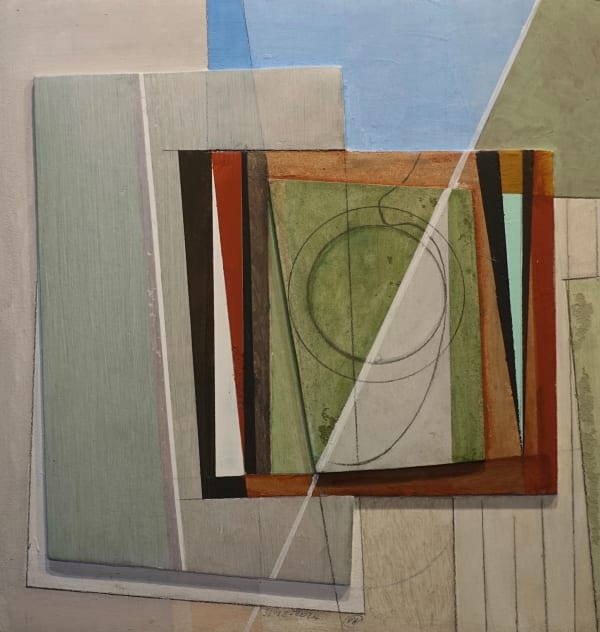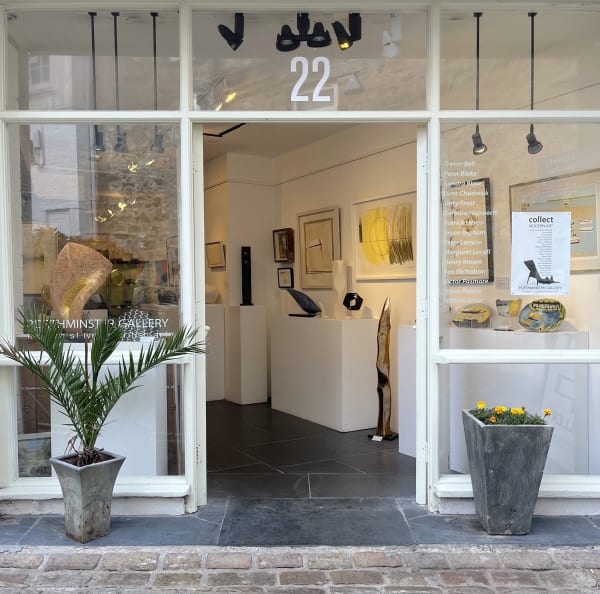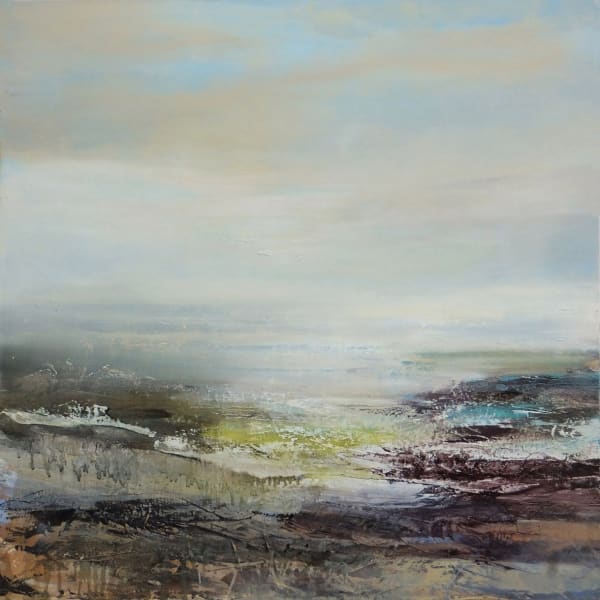Patrick Haughton British, b. 1942
“Over the past year or so, my work has shifted its emphasis, from reflections on landscape, to wider concerns regarding a sense of time and place. I am fascinated by ways in which the transitory nature of our existence is demonstrated: by traces of former human activity and through the action of natural forces on the physical world. "
Patrick Haughton was born in Devonport in 1942 and educated in Barnstaple, North Devon, moving to study architecture in Exeter in 1960. He was encouraged to paint by the artist, Nicholas Eastwood, and in 1962 abandoned architecture to enrol at Exeter College of Art. He subsequently transferred to the West of England College of Art in Bristol, where he studied painting and sculpture. Paul Feiler was head of painting at that time, and visitors included William Scott and Karl Weschke.
On leaving art school, Patrick qualified as a teacher, and moved to Kent. He returned to the South West in 1975, becoming head teacher of a small rural school in 1982. Since retiring from teaching in 1995, he has worked as a full-time artist. He was elected as a full member of Newlyn Society of Artists in 1995, is a member of the National Acrylic Painters Association, an academician of the South West Academy of Fine and Applied Arts (SWac) and is an associate member of the Penwith Society of Arts. In addition Patrick co-presents a regular jazz radio programme, ‘Jazz Train,’ for Source FM, and has designed sets and props for Quirk Theatre in Exeter, and The Cornish Theatre Collective. He now lives and works in Penryn, overlooking the estuary of the River Fal, in Cornwall, and spends prolonged periods of time in Brittany.
Patrick is a master of proportion and delicate balance. His paintings and painted relief constructions employ an elegantly understated simplicity, which weld together precision with an astonishing finesse of expressive line. His works culminate in an acute portrayal of the elemental nature of the landscape and the powers which shape it. Of late Patrick has embraced a wider exploration of the remnant, fugitive shadows residually tracing the passage of life through time and place. In these works, incisive collision is spliced with elusive fragmentation, on that sub-level where inspiration meets tangible reality. The abstract fluidity of his lines and fields of colour achieve a harmonious resonance, aligned with a satisfying, oblique symmetry, which together with his meticulous quality of draughtsmanship, evoke a deep emotional response.
Of his work, Patrick says "Works evolve through the process of making, of constructing and assembling, drawing, painting, on canvas, board or paper. I search for a visual language, which will communicate my perceptions of place and time, sometimes incorporating fragments of found objects and documents, which bring elements of reality into the work. Influences on my painting are many. Visual artists such as Picasso, Braque and Nicholson, Brancusi and Hepworth are clearly important to me, but the music played in the studio – anything from the 18th century baroque to the 20th century composers, also including jazz music of all periods – has its own effect on the structure and content of work. In the final analysis I would hope that the work is an honest reflection of my experience of life”.
-

PATRICK HAUGHTON | EARTH SONG
6 Mar - 25 Apr 2025The Porthminster Gallery presents Patrick Haughton – Earth Song , an exhibition of new and recent elegantly understated paintings and painted relief constructions on board, inspired by the ancient landscapes...Read more -

COLLECT | MODERN ART
9 Sep - 4 Nov 2023Gallery exhibition of Modern St Ives and British art for sale, featuring art – paintings, prints, drawings, and sculptures – by leading 20th Century artists, including: Wilhelmina BARNS-GRAHAM, Peter BLAKE, Sandra BLOW, Patrick CAULFIELD, Lynn CHADWICK, Maurice COCKRILL, Terry FROST, Barbara HEPWORTH, Patrick HERON, David HOCKNEY, Bryan INGHAM, Albert IRVIN, Margaret LOVELL, Henry MOORE, Ben NICHOLSON, Victor PASMORE, Bryan PEARCE, Tommy ROWE, William SCOTT, Joe TILSON.Read more -

PENWITH RHYTHMS: ANCIENT AND SACRED LANDSCAPE
Cornwall’s Prehistoric landscape is the focus of this exhibition of guest artists’ works 23 Oct - 27 Nov 2021The dramatic landscape of west Cornwall has captured the imagination of writers and artists for three centuries, and now this ancient and sacred landscape is explored and celebrated anew in...Read more -

RELOCATION
11 Sep - 24 Oct 2020The opening collection at our new premises at 22 Fore Street is a changing showcase of artworks by some of the many established and emerging British Artists whom we represent,...Read more -

RENEWAL
28 Mar - 30 Jun 2020After a long winter of being battered by seemingly constant storms and now the Coronavirus-19 lockdown, Porthminster Gallery begins its 2020 season of specially-curated seasonal shows with an online exhibition...Read more -

GALLERY RE-OPENING: 2020
14 Feb - 27 Mar 2020Porthminster Gallery celebrates its 2020 re-opening with a mixed exhibition of vibrant new abstract paintings by gallery artists, Ian Harrold and Patrick Haughton and a fresh collection of hypnotic seascapes...Read more -

LAYERS
New Paintings by Patrick Haughton and Masako Tobita 20 Oct - 17 Nov 2018A selling show of new paintings by two artists whose works are concerned with layerings of time, space and place: Patrick Haughton Masako TobitaRead more -

ST IVES SUMMER SHOW: 10
17 Jun - 3 Sep 2017Our tenth annual summer exhibition is a richly diverse showcase of expressive and sometimes surprising works by eight artists, all of whom are inspired by St Ives and Cornwall: Painters:...Read more -

BEN NICHOLSON | GREEK & TURKISH FORMS
The Porthminster Gallery presents Ben Nicholson – Greek & Turkish Forms , a selling exhibition of framed signed etchings from Nicholson’s 1967–68 suite. Based on drawings of Aegean motifs and...Read more
